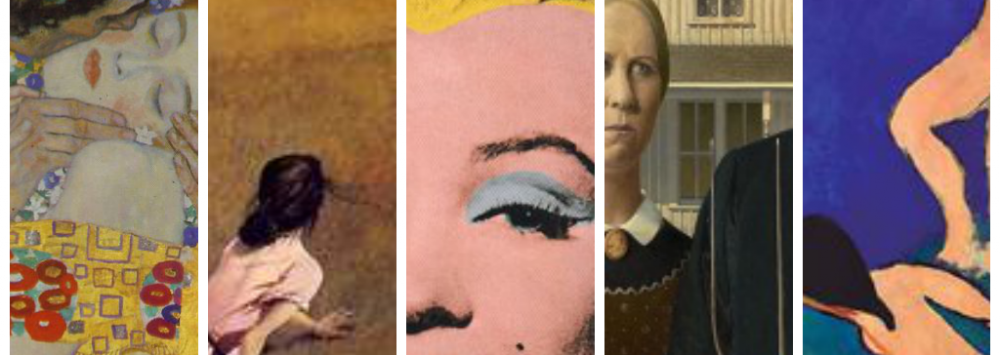WILLEM DE KOONING Katie McCarthy
BIOGRAPHY Willem De Kooning was an American painter born in Rotterdam, Netherlands on April 24, 1904. His parents divorced when he was five and he lived with his mother and stepfather. At the age of twelve, he apprenticed as a commercial artist, and additionally started taking night classes at the Rotterdam Academy of Fine Arts and Techniques. After studying at the academy for eight years he studied and at the Académie royale des Beaux-Arts in Brussels and the van Schelling School of Design in Antwerp. He then worked as an art director for a department store and soon moved to America where he worked illegally for a number of years. De Kooning first lived in Hoboken, New Jersey, but soon settled in New York (the center of Abstract Expressionism), where he worked as a commercial artist, window dresser, sign painter, and carpenter. De Kooning worked in a studio with artists John Graham and Arshile Gorky, who he became close friends with and was quite influenced by. He also worked for the Federal Art Project (WPA), but had to resign due to his lack of citizenship (he became a legal American in 1962). While out of work he was able to fully devote his time to his creative works. He married Elaine Fried who was also an artist and moved to Springs on Long Island. He was awarded the “Presidential Medal of Freedom” and his work was widely displayed. He died in Springs March 19, 1997. ABSTRACT EXPRESSIONISM AND DE KOONING De Kooning deeply exhibits abstract expressionism with it’s gestural, expressive style, and action painting technique. He is known as one of the more prominent artists of the movement alongside Pollock. And, he was located in the heart of the movement–Manhattan, New York. DESCRIPTION OF MEDIA, TECHNIQUE, AND INFLUENCE De Kooning was very inspired by Surrealists Gorky (his studio partner) and Picasso, but also by gesturalism demonstrated by Pollock and Kline. De Kooning worked mostly with oil paint, but did explore a few other mediums as well, such as bronze sculpture. He additionally worked on murals and more constructive work (in his early career). He focused on subjects such as landscapes, people (both women and men), and still lifes; even though sometimes his subject matter is hard to distinguish. He went through a black and white phase of abstract pieces, this came about because he was was too poor to buy artists pigment, and so just used black and white house paint. As William Wegman informed me, sometimes the success of your work comes from your limitations. I think this was very true of De Kooning. 21ST CENTURY COMPARISON: Georg Baselitz The two artists are comparable in their technique of expressive, colorful, linear and sectional painting. Both artists incorporate contrasts of color to add visual interest. And, both also use a variety of both color blocking (sections of various size and shape) and line structure. I particularly like the pure springy colors and pastels in Baselitz’s work; especially against the contrast of the white and black components. I’m very intrigued by the style of the work–it really just looks like fun. PERSONAL REFLECTION I was very drawn to De Koonings work because it felt very free, and I aspire to have the same sense of freedom in my work someday. Additionally, I was more drawn to his more colorful pieces that include a strong sense of color blocking. I also found his portraits of women to be quite amusing. BIBLIOGRAPHY “Abstract Expressionism.” MoMA Learning. MoMA, n.d. Web. 02 May 2014. . The Editors of Encyclopædia Britannica. “Willem De Kooning (American Artist).”Encyclopedia Britannica Online. Encyclopedia Britannica, n.d. Web. 01 May 2014. . “William De Kooning.” Collection Online. Guggenheim, n.d. Web. 02 May 2014. . “Willem De Kooning Biography.” Art Directory. N.p., n.d. Web. 02 May 2014. . WILLEM DE KOONING (very little information available) “Woman I” 1952, oil on canvas, 192.7 x 147.3 cm “Abstraction” 1950 “Untitled I” 1981 “Untitled I” 1977, oil on canvas, 195.6 x 223.5 cm “Pink Angels” 1945, oil and charcoal on canvas, 132.1 x 101.6 cm “Painting” 1948 “White Nude” 1967 “Triptych (untitled V, untitled II, untitled IV)” 1985 GEORGE BASELITZ “Licht wil raum mecht hern (Lef el rial bel),” 2013, oil on canvas, 300 x 275 cm “Ill wam ruch nichtet mehr (Ill bar fe well),”2013, oil on canvas, 300 x 275 cm 









 >
>
